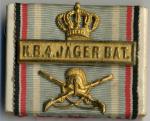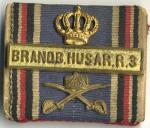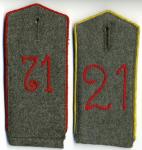-
Posts
2,962 -
Joined
-
Last visited
Content Type
Profiles
Forums
Blogs
Gallery
Events
Store
Everything posted by Chip
-

Shoulder boards
Chip replied to ccj's topic in Germany: Imperial Uniforms, Headwear, Insignia & Personal Equipment
Charles, There are a few addition dart colors (Faden - literally "threads") out there that you did not mention. First, the Baden colors, red/yellow appear on certain types of straps. The ones that I have seen were non-official officer's types. The two examples I can remember were a medical doctor's boards and the commander's board of the J?ger Rgt.Nr.3 (Ralf von Rango). I think this was a personal choice, especially in the case of von Rango, who was leading a mixed regiment of Prussians, Bavarians and Badeners. Another type is the blue darts of the Beamten. All Beamten, regardless of their home state, had the blue darts. They are often mistaken for Bavarian darts. It's the state Wappen that is the identifying mark on a Beamten board. The addition of the white darts to those that had previously only had one color (blue/white, black/white, etc.) came with M15 Feldachselst?cke. States with more than one color already remained the same (red/black - W?rttemberg, red/yellow/blue - Mecklenburg). Cockades changed over time, depending on the period. What time frame are you interested in? Chip -
vodorosl, There are several sources for the information that you seek. The 1999 two volume set of books from J?rgen Kraus has plates that show both the shoulder strap cyphers and the specialty shoulder strap devices (like the one you have shown and many others). These books are currently unavailable, but are supposed to be reprinted at some point. The regimental cyphers are shown in the "Handbook of the German Army" reprints, the Jan Kube books, Das Deutsche Heer, F?hrer durch Heer und Fl?tte and the various Ruhl uniform plates, some of which have been reprinted and are carried in stock by several militaria dealers. Finally, if you are interested, I can send you scans from any of the aforementioned books. Regards, Chip PS Your ?skulapstab insignia looks to be from the pre-1918 era.
-

Gotcha Covered!
Chip replied to Tom Y's topic in Germany: Imperial Uniforms, Headwear, Insignia & Personal Equipment
Why didn't I think of that! :speechless: -

Gotcha Covered!
Chip replied to Tom Y's topic in Germany: Imperial Uniforms, Headwear, Insignia & Personal Equipment
Tom, That's a cool accessory. You rarely see them. But, man, you need to learn how to fold a Zeltbahn! Chip -
All I can say at the moment, based on the reference material that I have, is that the regimental cypher was changed some time between 1899 and 1914. I have an 1899 dated Ruhl book that shows the 100th's cypher as the "AR". I have several references that show it having changed to "FAR" by 1914. Another change was made in that the cypher and crown, which had been made from yellow material (cord and cloth), were changed to white for the Dunkelblau uniform. While there is plenty of information about the Prussian cyphers and their changes in Paul Pietsch's two volume work, there is nothing equivalent that I know of for the Saxon army. I'm sure something exists, but there just has not been a modern reprint. Chip
-
First, of all. I did not have this example from the K.S.1.(Leib) Gren.Rgt.Nr.100 until this week. It is totally new to me. It is the same as the one that Charles has shown, i.e, both from this regiment. Secondly, I believe there were two different cypher patterns for King Friedrich August of Saxony (as you have observed), just as there was more than one style of royal cypher for the Kaiser. It is possible that the cyphers refer to different King Friedrichs, as the Saxon king crowned in 1905 was the third King Friedrich August (III) of Saxony. As far as I know, the "Saxon 100 Gren-Landwehr Regt. " would have drawn its uniforms from the depot of the line unit and would most likely have been given whatever was on hand. Normally, only the line units wore the cyphers, while the reserve and Landwehr units wore the regimental number on their shoulder straps. There is plenty of period photographic evidence, however, showing that this was not always the case. Chip
-
Cherie, Though you may be able to pin down with some certainty which unit captured or held your grandfather, the basement where he was being held was most likely a temporary site, maybe spur of the moment or maybe an assembly place before prisoners were sent on to established camps. While you might gain a little more background information, looking for this church might be like looking for a needle in a haystack when you don't know where the haystack is. You may just have to settle for "he was held somewhere behind the front in the area of......". Good luck with your search. Chip
-
Charles, This a well-known (and very cool) photo. I have a copy of it myself. Not much to the sleeve insignia. I believe the insignia was applied to the sleeve in pieces, that is, it was not on a patch.
-
Charles, You know I do. Chip
-
Charles, The Hoch u. Deutschmeister regiment and the Edelwei?korps badges are some of the most desirable and thus most expensive. In the last decade there has been a great influx of Italian collectors into WWI Austro-Hungarian collecting (for obvious reasons) and with the value of the Euro, most of the nicer badges have skyrocketed in value. This used to be a very affordable area to collect in, but like everything else, it has gotten out of reach for the average collector. I am fortunate to have started collecting cap badges in the 1980s when the average price was about $15.00. Today, I would venture to say that the average is about $45.00 or more. Chip
-

Austria-Hungary Austrian flyers collar device
Chip replied to Ferg1's topic in Austro-Hungarian Empire
-
Charles, Normally, you can just look up the unit to see if it makes sense. Like on this Train strap. Can it be infantry, no, there were no blue piped infantry units with the number "1". Cavalry, no. Artillery, no. Etc. It's a process of eliminationl. It works 99% of the time. Occasionally, there are two unit possibilities, but this is the exception rather than the rule. So for instance, can you tell me what unit the yellow piped strap on the right represents? Chip
-
Charles, The Eisenbahn units were part of the Verkehrstruppen and for the most part wore the uniform of the Garde-Pioniere (with their own shoulder boards. The Train (as in supply train) included a multitude of formations, including horse depots, bakery columns and originally, part of the medical establishment. Light blue was color of the piping until the fall of 1915 when the new darker blue color, "Kaliblau" was adopted. Bavarian Train troops wore the medical style cap with blue band and red piping. The troops for the munitions columns were supplied by the Train establishment, but wore the uniforms of their associated unit. Chip
-
The top photo looks to me to be a navy man. The bridal on the epaulettes is typical of certain ranks of the navy. The uniform in the second photo is somewhat perplexing. What interests me is the plain collar. He must be some sort of official, as Rick has said. Are any of those medals down the front of his tunic, non-German? Chip










